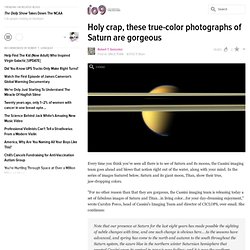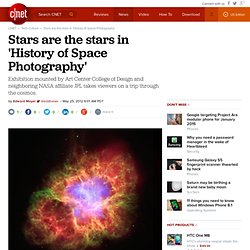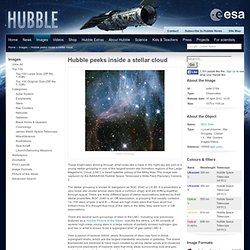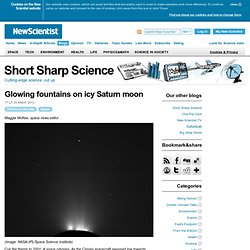

Sunset behind Gale's western rim, Curiosity sol 587. Join our eNewsletter for updates & action alerts The Bruce Murray Space Image Library Filed under pretty pictures, amateur image processing, Mars, Curiosity (Mars Science Laboratory) Go Back A blue halo surrounds the just-set Sun in this 6-image mosaic taken by Curiosity on sol 587 (April 1, 2014).

What The Night Sky Would Look Like From Inside A Globular Cluster. Moon as Art: Help NASA Choose the Most Beautiful Lunar Image. Sculptor Galaxy Seen as Infrared Rainbow. What The Night Sky Would Look Like From Inside A Globular Cluster. Space Photo of the Day - Wired Science. A detailed view of Betelgeuse on a collision course with a nearby wall of dust. Holy crap, these true-color photographs of Saturn are gorgeous. It's made me wonder, if you could stand on the surface of Saturn underneath the ring's shadow, what what it look like - the gauzy curtain through which you can still see the stars or sun that assorted sci fi movies and tv shows would have us believe, or would it be more akin to the huge blocks which blot out the light on Ringworld, leaving vast swathes of the planet in darkness?

Just curious. Anyone? (I'm just guessing now.) I guess it would be like night here, This is a big shadow on a massiv planet we're talking about, that covers more land than the entire earth. So being on the planet by our perspective it woul probably not be that much diffrent. Amazing Astrophotography Lets You See Nebulae in 3D. The Flame Nebula. When Galaxies Collide: Beautiful Images of Cosmic Impacts. Infinity Imagined. Infinity Imagined.
Stars are the stars in 'History of Space Photography' The Williamson Gallery at Art Center College of Design in Pasadena, Calif., recently teamed with neighbor and NASA/Caltech affiliate the Jet Propulsion Laboratory to create an exhibition of photos that dazzles one with the visual extravagance of the cosmos.

"The History of Space Photography" features 150 images, selected by guest curator Jay Belloli and several consultants at JPL. Most are from the last 50 years or so, but some date back as far as the 19th century. The exhibition wrapped up its inaugural showing at Art Center earlier in May, but it's scheduled to begin a tour of science museums in India this November, and will touch down at the George Eastman House International Museum of Photography and Film in New York next year. (Space fanatics should get started on those travel arrangements now.) Infinity Imagined. Broken Sea. Pink Opaque. Hubble peeks inside a stellar cloud. These bright stars shining through what looks like a haze in the night sky are part of a young stellar grouping in one of the largest known star formation regions of the Large Magellanic Cloud (LMC), a dwarf satellite galaxy of the Milky Way.

The image was captured by the NASA/ESA Hubble Space Telescope’s Wide Field Planetary Camera 2. The stellar grouping is known to stargazers as NGC 2040 or LH 88. It is essentially a very loose star cluster whose stars have a common origin and are drifting together through space. There are three different types of stellar associations defined by their stellar properties. NGC 2040 is an OB association, a grouping that usually contains 10–100 stars of type O and B — these are high-mass stars that have short but brilliant lives. Infinity Imagined. Infinity Imagined. Infinity Imagined. A moon casts a looooong shadow. Infinity Imagined. Infinity Imagined. A High Resolution Glimpse Of The Sun's Surface. Glowing fountains on icy Saturn moon. Maggie McKee, space news editor (Image: NASA/JPL/Space Science Institute)

Infinity Imagined. Man and Machine. An enigmatic blue bubble in space. There is something aesthetically pleasing about symmetry, whether it’s on Earth or as it is in the heavens.

That may be one of the reasons I love planetary nebulae, the eerie and beautiful structures created when dying stars cast off their outer layers. They come in many strange shapes, and oddly it’s quite rare to find one that appears perfectly circular. But they do exist, and one of the best examples I have seen yet is Abell 33, the glowing winds from a star located something like 1500 light years away: How gorgeous is that? [Click to embiggen.] A few things jumped out at me. Second, it looks like the central star may be a binary, two stars orbiting each other. A Stunning View Of The Horsehead Nebula. Hubble Views Grand Star-Forming Region.
Gumdrop Meets Spider. Saturn's Largest Moon Seen in Unprecedented Detail. Titan is one of the solar system’s coldest places, but that hasn’t stopped Saturn’s largest moon from being incredibly dynamic.A collection of 13 new studies about Titan show previously undetected craters and river deltas, and provide improved maps of its surface and interior.They also reveal new details about the moon’s mysterious 29.5-Earth-year-long seasonal cycle (the equivalent of one year on Saturn, which orbits the sun at a distance of 890 million miles).

“We’re really starting to see quite a lot of profound changes on Titan,” said planetary scientist Ralph Lorenz at Johns Hopkins University’s Applied Physics Laboratory. “We’re learning things now that you could only learn after years of repeat observations.”The findings come from nearly 8 years of observations by NASA’s Cassini spacecraft in the Saturn system.
Preview of a Forthcoming Supernova. Science Space Photo of the Day. When the lamp is shattered, The light in the dust lies dead.

When the cloud is scattered, The rainbow's glory is shed. These words, which open Shelley’s poem "When the Lamp is Shattered," employ visions of nature to symbolize life in decay and rebirth. It's as if he had somehow foreseen the creation of this new Gemini Legacy image, and penned a caption for it. What Gemini has captured is nothing short of poetry in motion: the colorful and dramatic tale of a life-and-death struggle between two galaxies interacting. All the action appears in a single frame, with the stunning polar-ring galaxy NGC 660 as the focus of attention.
Polar-ring galaxies are peculiar objects. Models of how polar-ring galaxies form offer two general formation scenarios: 1) a piercing merger between two galaxies aligned roughly at right angles, or 2) when the host galaxy tidally strips material from a passing gas-rich spiral and strews it into a ring. Infinity Imagined.